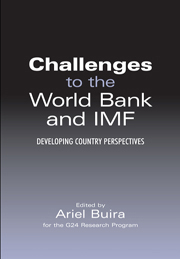Book contents
- Frontmatter
- Contents
- Contributors to this volume
- Foreword
- Introduction
- 1 The Governance of the IMF in a Global Economy
- 2 Who pays for the IMF?
- 3 An Analysis of IMF Conditionality
- 4 Achieving Long-Term Debt Sustainability in Heavily Indebted Poor Countries (HIPCs)
- 5 The Poverty Reduction Strategy Paper Approach: Good Marketing or Good Policy?
- 6 Capital Management Techniques in Developing Countries
- 7 International Reserves to Short-Term External Debt as an Indicator of External Vulnerability: The Experience of Mexico and Other Emerging Economies
- 8 Mechanisms for Dialogue and Debt-Crisis Workout that Can Strengthen Sovereign Lending to Developing Countries
- 9 Developing a Global Partnership for Development
- 10 International Financial Institutions and International Public Goods: Operational Implications for the World Bank
- Index
2 - Who pays for the IMF?
- Frontmatter
- Contents
- Contributors to this volume
- Foreword
- Introduction
- 1 The Governance of the IMF in a Global Economy
- 2 Who pays for the IMF?
- 3 An Analysis of IMF Conditionality
- 4 Achieving Long-Term Debt Sustainability in Heavily Indebted Poor Countries (HIPCs)
- 5 The Poverty Reduction Strategy Paper Approach: Good Marketing or Good Policy?
- 6 Capital Management Techniques in Developing Countries
- 7 International Reserves to Short-Term External Debt as an Indicator of External Vulnerability: The Experience of Mexico and Other Emerging Economies
- 8 Mechanisms for Dialogue and Debt-Crisis Workout that Can Strengthen Sovereign Lending to Developing Countries
- 9 Developing a Global Partnership for Development
- 10 International Financial Institutions and International Public Goods: Operational Implications for the World Bank
- Index
Summary
Abstract
In the context of the financial governance of the IMF, what are the equity implications of the manner in which the IMF distributes the cost of running its regular (non-concessionary) lending operations as well as the modalities of funding its concessionary lending and debt relief operations? While the IMF charges borrowers roughly what it pays its creditor members for the resources used in its regular lending operations, its overhead costs (administrative budget plus addition to reserves) are shared between the two groups of members in a less equitable manner. With the overhead costs rising inexorably to meet an increasing number and range of responsibilities being placed upon the institution – largely at the instance of the IMF's principal creditors by virtue of their dominant majority of voting power – the under-representation of the IMF's debtors undermines the legitimacy of its decision-making. With regard to the concessionary lending and debt-relief operations, some of the IMF's funding modalities have involved a substantial contribution by IMF debtors, sometimes under pressure. While this has been accepted as part of an intra-developing country burden-sharing exercise, it has also meant a significant burden shifting away from the developed countries in the cost of meeting their responsibilities to the poorest members of the international community.
Introduction
An important aspect of governance at the IMF relates to the cost of running the institution and the sharing of that cost between the industrial countries (the IMF's principal creditors) and low-income countries and emerging market economies (primarily borrowers).
- Type
- Chapter
- Information
- Challenges to the World Bank and IMFDeveloping Country Perspectives, pp. 37 - 54Publisher: Anthem PressPrint publication year: 2003
- 8
- Cited by

